Cardinal Ratzinger and the Rise of the Black Internationale - 2

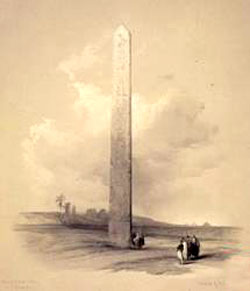
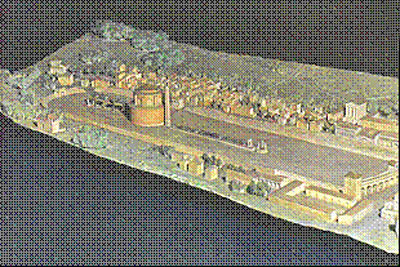
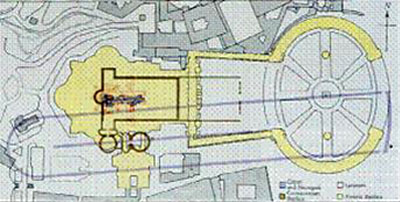
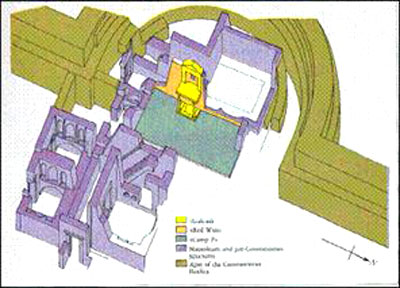
Today, the ministry and ritual worship within the Vatican no longer serves the God of Israel. They no longer seek to preserve the Torah that was given to Moses and His chosen ones fleeing their bondage in Egypt. The imperial religious center of the Pharaohs which the Israelites were fleeing from is now the entombed in the architecture and monuments at the Vatican. There in the home of apostate Christianity the monuments of the ancient Sun god, Ra reign supreme.
The Obelisk of the Egyptian Sun god Ra
The obelisk that is erected in the center of St. Peter’s Square in the Vatican is 83 feet high and weighs 331 tons. It was first erected under the orders of Emperor Augustus Caesar in the Julian Forum located in the city of Alexandria in the 1st century CE. It was later removed in 37 CE by the Emperor Caligula and placed in the Circus of Nero in Rome.
The obelisk that is erected in the center of St. Peter’s Square in the Vatican is 83 feet high and weighs 331 tons. It was first erected under the orders of Emperor Augustus Caesar in the Julian Forum located in the city of Alexandria in the 1st century CE. It was later removed in 37 CE by the Emperor Caligula and placed in the Circus of Nero in Rome.

The most famed and largest obelisk in the world, the Washington Monument is not from Egypt.
It stands in the Washington Mall of Washington D.C. the capital of the United States.
This Circus is called by some the Vatican Circus where the Apostle Peter was crucified. The word Vatican is a name that was coined centuries later where St. Peter’s Cathedral was erected.
As the Egyptologist Labib Habachi stated,
As the Egyptologist Labib Habachi stated,
Labib Habachi -"Legend has it that in the Vatican Circus innumerable Christians, including St. Peter, were put to death and that the reason this obelisk was not later overturned as were all the others in Rome was that it was looked upon as the last witness to the martyrdom of St. Peter."
This obelisk was never toppled and as such the emperor Nero obtained his mythical status as a sorcerer. On the top was erected a bronze globe with what was known to be the ashes of the two Caesars; Augustus and Tiberius.
In the year 1586, Felice Peretti, known as Pope Sixtus V (1585-1590) the “Iron Pope”, commissioned Domenico Fontana to transfer this obelisk from the Circus of Nero to what was to become the Piazza St. Pietro in front of the Basilica of St. Peter.
In the year 1586, Felice Peretti, known as Pope Sixtus V (1585-1590) the “Iron Pope”, commissioned Domenico Fontana to transfer this obelisk from the Circus of Nero to what was to become the Piazza St. Pietro in front of the Basilica of St. Peter.
Sixtus V was born on the little village of Montalto in the desolate area of Marca d’Ascoli. He later was known as Cardinal Montalto. On top was erected the complex coat of arms with four symbols; a rampant lion holding pears (Peretti means pears) and three mountains topped by a star, the mountains and the star of Sixtus V
There in the midst of the “Eight Wheel Path of Enlightenment” this obelisk stands as a symbol of the glory of Egypt and the imprint of Egyptian cultic influence on the Vatican over the ages.
There in the midst of the “Eight Wheel Path of Enlightenment” this obelisk stands as a symbol of the glory of Egypt and the imprint of Egyptian cultic influence on the Vatican over the ages.
The Egyptian Obelisk in the center of St. Peter’s Square
The entire path of enlightenment circles an obelisk called by some the Obelisk of Cleopatra was created in Egypt in the 1st century BCE. In the research of obelisks by the New Age author, Peter Tompkins in his book, The Magic of Obelisks, he writes the following:
Peter Thompkins –“The Egyptians had developed a means of placing theses huge blocks of granite directly onto a cubical pedestal which had to be absolutely level in order to have the apex of the obelisk truly vertical over its base…”(Thompkins, Peter, The Magic of Obelisks)
His research continued as to their purpose and use and found that the obelisk was used in the worship of the ancient Egyptian Sun god, “Ra”. (Ibid 7). To gain insight into this world of Black Magic, the author “encountered the murky worlds of witchcraft, voodoo, demonology, and the darkest recesses of the human mind”. (Ibid, p.2)
During this era, one of the oldest and most famous of the Egyptian obelisks is the obelisk of Heliopolis, most ancient surviving ‘needle’ in Egypt.
According to Thompkins, the obelisk of Heliopolis stood in the famed city of Heliopolis:
According to Thompkins, the obelisk of Heliopolis stood in the famed city of Heliopolis:
Peter Tompkins –“… with its temple to the sun, its 13,000 priests chanting before a huge mirror of burnished gold, the sacred hawk in the golden cage, the pyramidal ben-ben, and the sacred calf Mnevis on its purple bed, was the greatest theological center in ancient Egypt. …”(Thompkins, Peter, The Magic of Obelisks)

The obelisk of Heliopolis
This delta city of ancient Egypt, Heliopolis, was the capital of the 13th Lower Egyptian Nome. As a city of astronomy, the high priest took the title name held by Imhotep in the 3rd Egyptian dynasty, some scholars think was the Egyptian visor Joseph, the son if Jacob. He was called wr-m3w, or “chief of observers” or the “greatest of seers”. Heliopolis, called “On” in Egyptian Coptic, was the seat of the sun-god Ra was the oldest and richest of the ancient seats dedicated to sun worship.
Next to the obelisk of Heliopolis, the largest standing Egyptian obelisk today is standing in the Piazza S. Giovanni in Laterano, the square of St. John Lateran, the official cathedral of the bishop of Rome. This cathedral is called the Sacred Lateran Church, Universally for the City and the World, Supreme Mother of Churches.
This obelisk was the last obelisk to be brought from Egypt to Rome. Constantine the Great wanted to bring it but did not have a large enough ship to do so. It was Constantius II (317-361 CE) who had a specially built ship and transported it from Thebes to Rome in 357 CE. Located initially on the Circus Maximus, by the time of the reign of Pope Sixtus V, it had fallen, was broken and in disrepair. It was repaired and re-erected in the Piazza S. Giovanni in Laterano.
Next to the obelisk of Heliopolis, the largest standing Egyptian obelisk today is standing in the Piazza S. Giovanni in Laterano, the square of St. John Lateran, the official cathedral of the bishop of Rome. This cathedral is called the Sacred Lateran Church, Universally for the City and the World, Supreme Mother of Churches.
This obelisk was the last obelisk to be brought from Egypt to Rome. Constantine the Great wanted to bring it but did not have a large enough ship to do so. It was Constantius II (317-361 CE) who had a specially built ship and transported it from Thebes to Rome in 357 CE. Located initially on the Circus Maximus, by the time of the reign of Pope Sixtus V, it had fallen, was broken and in disrepair. It was repaired and re-erected in the Piazza S. Giovanni in Laterano.
The Karnak Obelisk of Thutmoses III standing in the Square of St. John Lateran.
Standing twenty meters high and weighing 21 tons, this obelisk was originally carved in the reign of the Egyptian reign of Pharaoh Thutmoses III and was placed in the temple of Amon-Ra in Karnak at Thebes. Thutmoses III was thought to be the brother to the foster mother of Moses, the Pharaoh Queen Hatshepsut.
Today in Rome, it represents the tallest and best preserved of Egypt’s ancient symbols to the sun. Also on top of this obelisk, Pope Sixtus V mounted the entire array of his heraldic symbols: not only the three mountains with the star, but also the lion holding the pears.
The followers of the pagan or satanic religions of Egypt believed that the spirit of Ra lived in the obelisk. Three times a day, the worshippers of Ra were to face this obelisk and to pray to the god, Ra. According to Cathy Burns in the book, “Masonic and Occult Symbols Illustrated” , this practice has been transmitted over the centuries in the occultic societies who also “face the obelisk” daily. Here the obelisk represented the phallus of Osiris which was cut into fourteen parts.
Today in Rome, it represents the tallest and best preserved of Egypt’s ancient symbols to the sun. Also on top of this obelisk, Pope Sixtus V mounted the entire array of his heraldic symbols: not only the three mountains with the star, but also the lion holding the pears.
The followers of the pagan or satanic religions of Egypt believed that the spirit of Ra lived in the obelisk. Three times a day, the worshippers of Ra were to face this obelisk and to pray to the god, Ra. According to Cathy Burns in the book, “Masonic and Occult Symbols Illustrated” , this practice has been transmitted over the centuries in the occultic societies who also “face the obelisk” daily. Here the obelisk represented the phallus of Osiris which was cut into fourteen parts.
This symbol was later transferred to the Canaanite god Baal, whom the prophets proclaimed the hatred of the God of Israel to this false religion. Later in the Mystery religions of the Greeks,
“Pan the goat god and god of sensuality were often represented by the obelisk.”(Burns, Cathy, Masonic and Occult Symbols Illustrated)
With the death of the famed Cleopatra, the last Pharaoh of Egypt and the wife of both Mark Anthony and Julius Caesar, we find the ascent of the glory of Rome while the glory of Egypt faded into history. The obelisks of Egypt were moved to many cities of the Roman Empire

The site of the execution of Paul and the crucifixion upside down of
the Apostle Peter in the Circus of Nero near the “Cleopatra Obelisk” of Egypt
It was in 66 CE when the Apostle Paul, the emissary of Yahshua to the gentiles was arrested and executed in the Circus of Nero. When the news reached Peter who was ministering to the Nazarene believers in Gaul (central Europe) that he immediately went to Rome to assist the fledging church.
They were meeting in the home of Senator Rufus Pudens and his Celtic Silurian wife who was the princess of Wales. Their home was known as the “Palladium Britannica” (the Palace of the British) where the Basilica Pudentianna presently stands in Rome today.
Soon after his arrival, Peter was arrested and put in the famed and feared Gemonium or the Tullian Keep known today as the Mamertine Prison. This two chambered cell was cut into solid rock, one over another with the only entrance through the ceiling. In 50 CE, it was described by the Roman historian Sallust as:
Soon after his arrival, Peter was arrested and put in the famed and feared Gemonium or the Tullian Keep known today as the Mamertine Prison. This two chambered cell was cut into solid rock, one over another with the only entrance through the ceiling. In 50 CE, it was described by the Roman historian Sallust as:
Roman historian Sallust -“In the prison called the Tulian, there is a place about ten feet deep. It is surrounded on the sides by walls and is closed above by a vaulted roof of stone. The appearance of it from the filth, the darkness and the smell is terrific.”(Taylor, John W., The Coming of the Saints)

The tomb of the Apostle Peter on the embankment of
the Circus of Nero at the site of the Great Altar of St. Peter’s Cathedral
According to George F. Jowett, in The Drama of the Lost Disciples we read:
George Jowett –“It was here that Jugurtha was starved and went insane, and Vereingirorix, the famed and feared Druidic Chief was murdered by Julius Caesar. Yet here incarcerated in the filth and stench of decades of human debris, Peter was bound in chains for nine months, standing upright to a column, never able to rest. Peter’s undaunted spirit was such, that in these nine months, he converted his gaolers, Processus, Martinianus, and forty-eight others to the ministry of Christ.”(Jowett, George F., The Drama of the Lost Disciples)
It was at the site of the Circus of Nero with the obelisk that was standing along the central spine, that the Apostle Peter was crucified upside down with his feet tied by a rope about 67 CE.

The tomb of Peter and the 1st century monument and graffiti in honor to him
in the catacomb beneath the “seat of Peter” in St. Peter’s Cathedral in the Vatican.
According the ancient traditions of the early church, the body of Peter was given to the believers of the Roman Christian Ecclesia whose home church was in the home of the Roman Senator Rufus Pudens at the Palladium Britannica on one of the seven hills of Rome called the Viminale Hill.
There they took his body to the surrounding embankment of the Circus of Nero and placed Peter’s grave. Later they build a memorial site for the Roman Christian believers. As seen in the picture above of the Circus of Nero, the site for the tomb of Peter was later built the altar of the Basilica of St. Peter’s by the Emperor Constantine. Later in the center of the piazza of St. Peter’s the Obelisk of Cleopatra was re-erected and once stood in the spine of the Circus of Nero.
There they took his body to the surrounding embankment of the Circus of Nero and placed Peter’s grave. Later they build a memorial site for the Roman Christian believers. As seen in the picture above of the Circus of Nero, the site for the tomb of Peter was later built the altar of the Basilica of St. Peter’s by the Emperor Constantine. Later in the center of the piazza of St. Peter’s the Obelisk of Cleopatra was re-erected and once stood in the spine of the Circus of Nero.
Today, the ministry and ritual worship within the Vatican no longer serves the God of Israel. They no longer seek to preserve the Torah that was given to Moses and His chosen ones fleeing their bondage in Egypt. The imperial religious center of the Pharaohs which the Israelites were fleeing from is now the entombed in the architecture and monuments at the Vatican. There in the home of apostate Christianity the monuments of the ancient Sun god, Ra reign supreme.

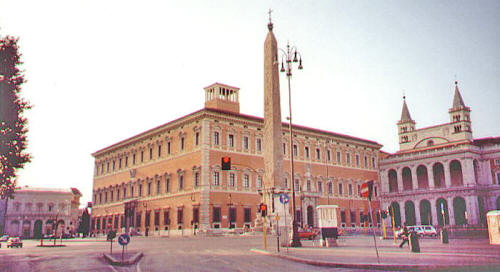
No comments:
Post a Comment